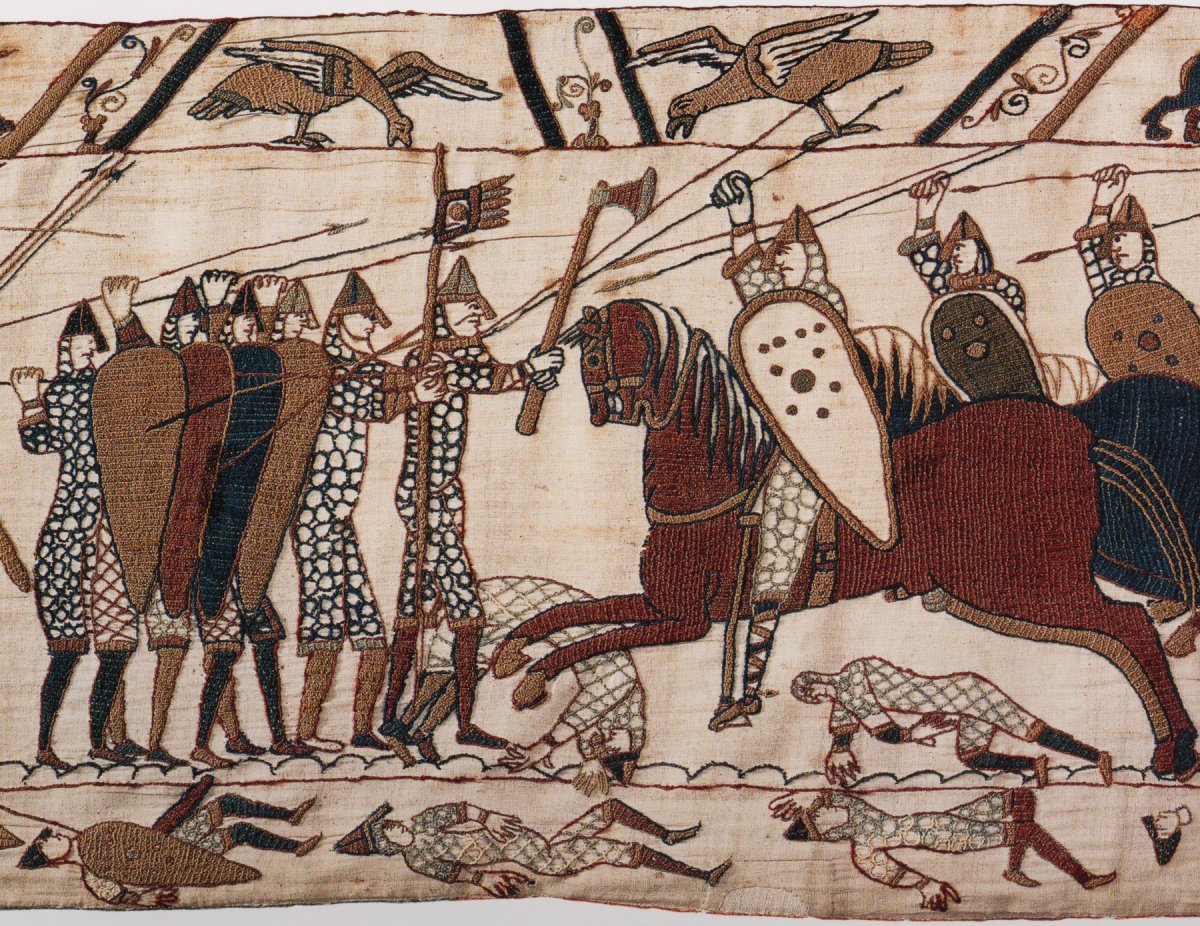William successfully asserted his rights over the vigorous and tough Norman nobility. He allowed no castle to be built without his license, and insisted that, once built, each castle be put at his disposal on demand. The Norman cavalry was formidable and early perfected the technique of charging with the lance held couched, so that all the force of horse and rider was concentrated in the point of the weapon at the moment of shock.
Infantry and bowmen supported the charge. As a result of trade with Scandinavia and England, Normandy was prosperous even beyond the norms of the eleventh-century revival. It enjoyed a flourishing agriculture, growing towns, a flowering of monastic learning and church building under ducal patronage, and an effective fiscal administration. Moreover, because William put down private warfare and efficiently dispensed justice, there was peace and order.
While facing England across the Channel, Normandy had always maintained contact with the Scandinavian lands of Norman origin. After the Danish invasions of England all three regions were closely involved in commercial relations and often in strife. Emma, daughter of a Norman duke, married first the Anglo-Saxon king Ethelred II (r. 978-1016), by whom she was the mother of Edward the Confessor, and then the Danish king Canute (r. 1016-1035), by whom she had a son, Harthacnut (r. 1040-1042).
William was her great- nephew. In the tangled English-Danish-Norman royal politics there were dark crimes, including the murder in 1036 of Edward the Confessor’s older brother Alfred. It was Norman nobles, favorites of Edward the Confessor, who built the first castles in England shortly before the conquest. Edward gave important posts in the English church to Norman clerics, and as early as 1051 Edward had recognized William as his rightful heir.
William’s invasion had the blessing of the papacy, which recognized his claim to the throne of England. William landed successfully and established two fortified beachheads on the Sussex coast. All was over in one hard day’s fighting as Norman horsemen and bowmen slaughtered Harold’s close-packed warriors, who were fighting on foot with battle-axes.
William was crowned on Christmas Day, 1066, by the archbishop of York. William seems to have taken special pains to prevent disorders. The Anglo-Saxon Chronicle, a collection of contemporary vernacular histories, says of him:
Amongst other things the good security that he made in this country is not forgotten—so that any man could travel over his kingdom without injury, with his bosom full of gold; and no one dared strike another, however much wrong he had done him.*
This was after William had taken possession of the whole of England, which took two campaigns in the far southwest and expeditions to the north in which William punished pro-Danish English rebels by destroying the crops and causing widespread famine. The last uprising in England was crushed in 1071 on the Isle of Ely, and in 1072 the Conqueror won the submission of the king of Scotland, who became his vassal. Each state was marked by the building of new castles to hold the region and enforce order; the former ruling class of England was replaced by Norman and French nobles.
All of England belonged to William by right of conquest. He kept about one sixth as royal domain, gave about half as fiefs to his great Norman barons, and returned to the church the quarter that it had held before. The barons owed military service only to William, and they swore primary allegiance to him in the Salisbury Oath of 1086, giving him authority that no French king would ever enjoy. The bishops and abbots also owed him feudal services. He forbade private war and allowed only royal coinage. He kept the Anglo- Saxon system of courts and bound local officials closely to the Crown by giving them wide local authority at the expense of bishop and earl.
The Conqueror thus maintained old English custom and law, while superimposing on it Norman feudal structure with its mounted knights and castles. The sheriffs provided continuity. The Norman curia regis met regularly three times a year, but could be summoned at any time to give counsel and try the cases of the great vassals. Its members also could be asked to perform special tasks in the shires—local administrative units that had been established in the early eleventh century and were divided into smaller units known as hundreds—for adjusting taxation, maintaining the peace, and settling local pleas.
In 1086 William ordered a careful survey of all landed property in England. The record of that survey is the Domesday Book, which included a full statement of ownership, past and present, for every piece of land, and a listing of all resources, so that the royal administration might learn whether and where more revenue could be obtained.
Tenants, plows, forest land, fish ponds—all were listed in Domesday Book. Those who collected the information from the old Anglo-Saxon subdivisions arranged it under the new Norman divisions. The Domesday Book, then, was a formal written record attesting to the introduction of feudal landholding and law into England.
With the assistance of an able Italian, Lanfranc (d. 1089), whom he made archbishop of Canterbury, William established continental practices in the English church. Norman churchmen gradually replaced the English bishops.
To commemorate the victory at Hastings, William founded Battle Abbey on the site of the battlefield; other monastic foundations followed, notably in the north. Norman abbots brought Latin books and learning from the Continent, and for a time vernacular writing in English ceased.
William refused the pope’s demand that feudal homage be done to him as overlord of England; he agreed only to pay the accustomed dues to the Church of Rome. The English church recognized no new pope without the king’s approval and accepted no papal commands without his assent.

